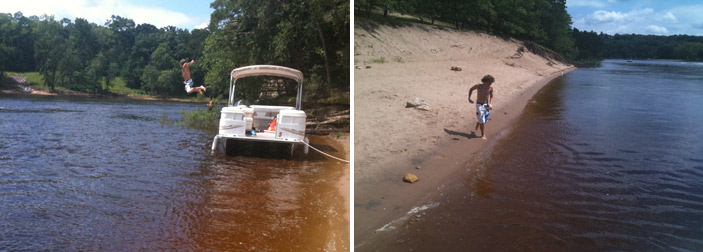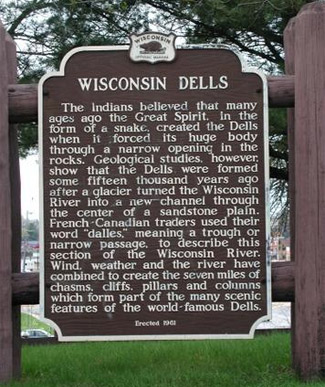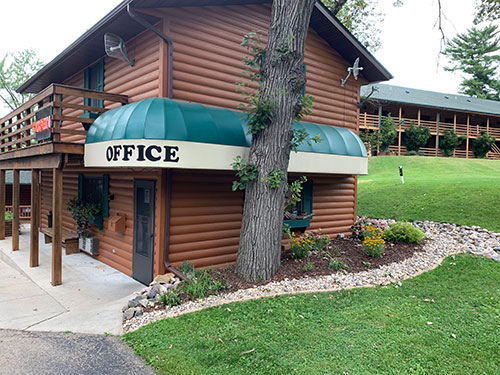Things To Do in the Wisconsin Dells
- Wisconsindellstaxi.com
- Ishnala.com
- DellsKnuckleheads.com
- Del-Bar.com
- Dells.com
- WisDells.com
- SpaSerinity.com
- LostCanyonTour.com
- Marleysclub.com
- Wisconsinducktours.com
- Wisconsin-Dells-Attractions.com
- Wisconsinbigcats.org
- Noahsarkwaterpark.com
- DellsSplashPass.com

Wisconsin Dells History
The Dells of the Wisconsin River also called the Wisconsin Dells is a 5 mile gorge on the Wisconsin River in southern Wisconsin in the United States noted for its scenic beauty, in particular for its unique sandstone rock formations and tributary canyons. The cliffs, some over 100 feet high, and side canyons are closed to the public to protect sensitive ecological features. The viewing of the rock formations by water is a popular tourist attraction in the area. The nearby city of Wisconsin Dells is the center of summer tourist activity, much of it in the form of the theme parks unrelated to the river features.
 The cultural history of the area stretches back several thousand years, from early Paleo-Indian people to the more recent Native American peoples, such as Ho-Chunk, Sac, and Menominee, who left behind effigy and burial mounds, camps and village sites, garden beds, and rock art. The Dells were made famous in 1886 by the photographer H. H. Bennett, who took the first stop-action photo of his son jumping onto Stand Rock.
The cultural history of the area stretches back several thousand years, from early Paleo-Indian people to the more recent Native American peoples, such as Ho-Chunk, Sac, and Menominee, who left behind effigy and burial mounds, camps and village sites, garden beds, and rock art. The Dells were made famous in 1886 by the photographer H. H. Bennett, who took the first stop-action photo of his son jumping onto Stand Rock.
Wisconsin Dells was founded as Kilbourn City in 1857 by Byron Kilbourn, who is notable for also founding Kilbourntown, one of the three original towns at the confluence of the Milwaukee, Menomonee, and Kinnickinnic Rivers that joined to become Milwaukee. Before the establishment of Kilbourn City, the region around the dells of the Wisconsin River was primarily a lumbering area until 1851, when the La Crosse and Milwaukee Railroad was chartered with Kilbourn as its president. The railroad made plans to bridge the Wisconsin River near the river’s dells, and a boomtown named Newport sprang up at the expected site of the bridge in 1853. The population of this new city quickly swelled to over 2,000, but when the railroad finally came through the area in 1857 it took nearly everyone by surprise by crossing the river a mile upstream from the site of Newport. As a result, Newport was rapidly turned into a ghost town as the settlers flocked to the new city at the site of the railroad bridge, Kilbourn City. Gradually, tourism became a large part of Kilbourn City. To make it easier for tourists to identify Kilbourn City with the natural landscape it was famous for, the name of the city was changed to Wisconsin Dells.
 Because of the scenery provided by the dells of the Wisconsin River, Kilbourn City quickly became a popular travel destination in the Midwest. In 1875, early landscape photographer H. H. Bennett established a studio in the city and took several photos of the sandstone formations in the dells, including many stereoscopic views. Prints of these photographs were distributed across the United States, further enhancing the status of Kilbourn City as a destination for sightseers. Taking advantage of this, Bennett began offering to take souvenir pictures of visitors to the dells, becoming one of the first to capitalize on the area’s burgeoning tourist trade. Today, the H. H. Bennett Studio is an historic site operated by the Wisconsin Historical Society.
Because of the scenery provided by the dells of the Wisconsin River, Kilbourn City quickly became a popular travel destination in the Midwest. In 1875, early landscape photographer H. H. Bennett established a studio in the city and took several photos of the sandstone formations in the dells, including many stereoscopic views. Prints of these photographs were distributed across the United States, further enhancing the status of Kilbourn City as a destination for sightseers. Taking advantage of this, Bennett began offering to take souvenir pictures of visitors to the dells, becoming one of the first to capitalize on the area’s burgeoning tourist trade. Today, the H. H. Bennett Studio is an historic site operated by the Wisconsin Historical Society.
The dells region remained primarily a place for sightseers to escape the bustle of the city for many decades. In 1856, Leroy Gates began taking tourists on boat tours of the Wisconsin Dells. These boat tours were given using wooden rowboats until 1873 when the first steamboat, the Modocawanda, was used. By 1894, gasoline powered tourboats were used for the tours. In 1908, the Kilbourn Dam was installed despite protests from people such as H. H. Bennett, separating the Dells into the Upper and Lower Dells. Since the time of LeRoy Gates, the Dells Boat Tours have gone through many owners. Some of these previous companies were The Riverview Boat Line, The Olson Boat Line (owned by Jack B. Olson), and The Dells Boat Company.
A few other events of interest took place during this time, including the June 16, 1911, impact of a 772-gram stony meteorite in rural Columbia County near the city, damaging a barn. In 1931 Kilbourn City was renamed Wisconsin Dells after the natural feature which was drawing so many visitors to the town. As the twentieth century progressed, new attractions would begin to draw even more tourists.
In 1946 a Milwaukee native named Mel Flath brought the first DUKW to the Wisconsin Dells. It was an impulse buy which he made at a government auction in California; The trips purpose was to purchase war surplus trucks. Mel opened the “Dells Amphibian Line” which gave 90 minute tours in the Wisconsin River, exposing tourists to the area’s famous sandstone formations. Mel would eventually sell his duck fleet to the Associated Boat lines in 1952, which renamed themselves, the Wisconsin Ducks, Inc. In 1952 the Wisconsin Ducks, Inc. began offering tours of the river dells and adjacent areas using decommissioned amphibious DUKW vehicles from World War II. Jack B. Olson started the Wisconsin Ducks, Inc.; they remain one of the area’s most popular attractions. However, duck competition was far from over after the 1952 sale. Mel Flath would open up a duck ride again briefly from 1964 – 1966. When he was bought out again, the Soma Boat Company opened up their own duck ride on Mirror Lake, near Lake Delton, WI, which they called the Aquaducks. In response to the competition, Wisconsin Ducks, Inc. took on the name “Original Wisconsin Ducks.” The Aquaducks existed from 1968 until their sale to the boat lines in 1976. In 1977 yet another duck ride began, this time by Mel Flath’s daughter and son-in-law, George and Suzanne Field, named Dells Duck Tours, Inc. operating from the same property Mel did 30 years prior. This time sporting a red, white and blue exterior, these ducks, while not the “original” ducks that were first brought here, were still actual World War II production models. Today, the Dells Duck Tours, Inc. are known as the Dells Army Ducks after a paint scheme change in 2002.
Lake Delton, Wisconsin Dells’ sister city to the south, gradually became popular as the Dells attractions spread out. In 1952, a new traveling performance from Chicago called the “Tommy Bartlett’s Thrill Show” came to Lake Delton on its second stop. Following the show’s huge success in the city, the show’s owner, Tommy Bartlett, chose to keep the performances permanently in Wisconsin Dells. To promote the show, Bartlett gave away bumper stickers advertising his thrill show and the city, effectively spreading word about the area across the nation. Soon more attractions followed to serve the ever-increasing number of tourists, along with countless hotels, shops, and restaurants.










